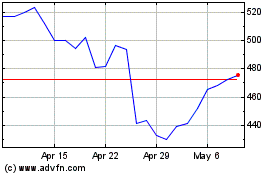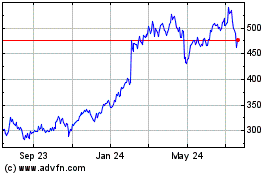By Mike Shields
A pair of top advertising trade groups are urging publishers to
consider adopting a uniform means of tracking whether ads can be
seen in their mobile apps.
Ad buyers are hoping the move may spur the likes of Google and
Facebook, which dominate digital advertising, to eventually come on
board.
As more ad budgets shift toward targeting people on mobile
devices, both the American Association of Advertising Agencies
(known as the 4A's) and the Interactive Advertising Bureau (known
as the IAB) are coming out in support of an open source initiative
aimed at standardizing viewability measurement for mobile apps.
Specifically, the vision is for the industry to jointly develop
a single code base that mobile publishers can plug into their apps,
letting advertisers pull data on viewability in a standard fashion,
said Joe Barone, managing partner of digital ad operations for
GroupM and chairman of the 4A's Digital Operations & Technology
Committee.
Mobile advertising is expected to grow at a rapid clip over the
next few years, as Americans become more and more glued to their
mobile devices. But marketers continue to scrutinize digital ad
budgets, as the industry has grappled with fraudulent ad space and
brands spending money on ads that people never see.
Thus, proving that ads are viewable has become table stakes in
many digital ad negotiations. Yet in the mobile app world, the
proliferation of viewability tracking vendors has forced ad buyers
to reconcile inconsistent data sets for many ad campaigns.
Meanwhile, publishers, even as they look to protect their user
experience, are often forced to integrate software from multiple
third paries that can slow down their apps.
The plan is to have various constituencies from the industry
develop a standard tracking code over the next several months, with
the IAB overseeing the collaboration.
"This will be a very regimented, very democratic process," said
Alanna Gombert, general manager of the IAB Tech Lab.
Tracking whether ads are viewable in mobile apps is trickier
than on desktops, say ad buyers, since it requires a unique
technological solution -- one that often must be applied app by
app.
And even as more mobile publishers have worked to integrate
various viewability tracking partners, ad buyers remain frustrated
that Google and Facebook have been hesitant to allow for the same
level of direct data collection. This frustration has only been
exacerbated by a string of recent metrics miscalculations by
Facebook.
Google, for its part, says it has agreed to participate in the
open source initiative, but hasn't yet committed to put any new
tracking code directly in its mobile apps.
The fundamental data marketers require to make sure people are
seeing their mobile ads remains a point of friction in the ad
world.
According to Mr. Barone of the 4A's, a single piece of code will
make it much easier for both apps and advertisers to track mobile
ad campaigns without having to implement multiple sets of tracking
vendors and having to reconcile different data sets. "This is a
search for consistency," he said. "We believe viewability data
ultimately becomes a commodity."
But as with any industrywide initiative, consensus won't
necessarily be easy. Right now, many ad buyers and publishers work
with their own preferred vendors for tracking viewability and may
be reluctant to change things up.
"I'm cautiously optimistic," said Wayne Gattinella, chief
executive of the ad tracking firm DoubleVerify. "The devil is in
the details, and there are a lot of details."
Some third-party data companies may ultimately feel as though
their proprietary tracking code is part of what makes their
services unique -- and that their data is far from a commodity. If
everyone in mobile advertising starts using the same tracking code,
it's possible some might question the value of multiple third-party
measurement firms.
Moat Chief Executive Jonah Goodhart said he plans to contribute
some code to the open source initiative, but said that any
standardized offering won't have the same breadth of metrics a
custom integration would.
A comScore spokesperson said the research company supports the
idea of streamlining viewability measurement -- as long as there
are assurances that the quality and sophistication of such data
collection is maintained.
The viewability tracking company Integral Ad Science (IAS) is
very much on board with the concept. In fact, last month IAS
announced it's own open source code plan, which had the support of
several mobile ad companies.
Without something like this, mobile advertising won't grow as
fast as it should, argued IAS Chief Executive Scott Knoll. "We're
kind of at a standstill," he said.
Jeff Coon, vice president of global alliances for the mobile ad
firm inMobi -- which helps sell ads for 30,000 apps -- said that
working with multiple metrics vendors is a major headache, since
any tweak to their tracking software often requires individual apps
to have to go through the app store approval processes again. Thus,
he's fully supportive of an open source initiative.
"These viewability vendors, I've told them, 'You're all writing
same code, get over it,'" he said.
Regardless, there's the big open question of whether the
industry's mobile app giants -- Facebook and Google, not to mention
Snapchat -- will be on board with directly implementing third-party
tracking code of any kind.
"It would be really good if they were," said Mitchell Weinstein,
senior vice president of ad operations at the media buying firm IPG
Mediabrands. "We hope that if there's enough buying pressure
they'll seriously consider it."
Write to Mike Shields at mike.shields@wsj.com
(END) Dow Jones Newswires
January 06, 2017 14:17 ET (19:17 GMT)
Copyright (c) 2017 Dow Jones & Company, Inc.
Meta Platforms (NASDAQ:META)
Historical Stock Chart
From Aug 2024 to Sep 2024

Meta Platforms (NASDAQ:META)
Historical Stock Chart
From Sep 2023 to Sep 2024
